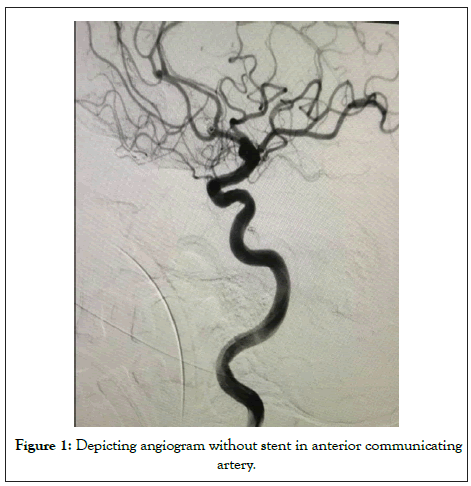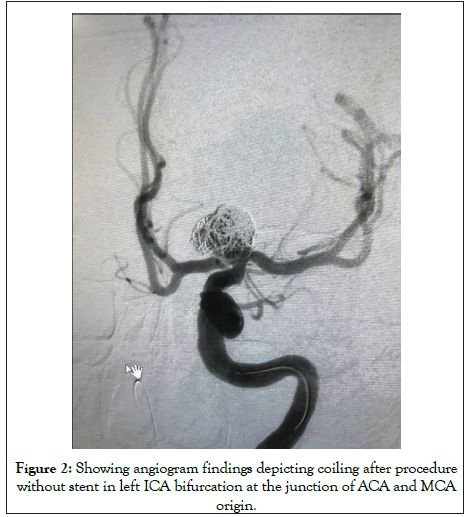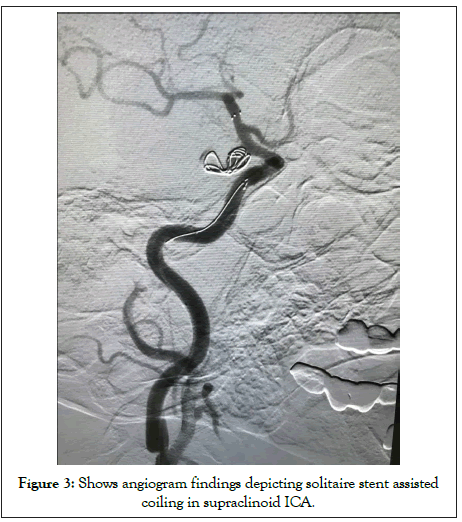Indexed In
- Open J Gate
- Academic Keys
- RefSeek
- Hamdard University
- EBSCO A-Z
- OCLC- WorldCat
- Publons
- Euro Pub
- Google Scholar
- SHERPA ROMEO
Useful Links
Share This Page
Journal Flyer

Open Access Journals
- Agri and Aquaculture
- Biochemistry
- Bioinformatics & Systems Biology
- Business & Management
- Chemistry
- Clinical Sciences
- Engineering
- Food & Nutrition
- General Science
- Genetics & Molecular Biology
- Immunology & Microbiology
- Medical Sciences
- Neuroscience & Psychology
- Nursing & Health Care
- Pharmaceutical Sciences
Case Report - (2021) Volume 9, Issue 5
Assessment of Feasibility, Safety, and Efficacy of Temporary Solitaire Stent Assisted Coiling in Cases of Wide Necked Aneurysms: A Series of Case Reports
Rahul Pathak*, Deka Saurav and Chandolia BetinaReceived: 26-Aug-2021 Published: 16-Sep-2021, DOI: 10.35248/2329-6925.21.9.425
Abstract
Wide-necked aneurysms require comparatively more advanced endovascular and microsurgical techniques than those required for narrow-necked aneurysms. Temporary solitaire stent-assisted coiling technique is used for treating wide neck aneurysms with the advantage of non-requirement of antiplatelet therapy to prevent in-stent thrombosis. We present a case series comprising of three case reports that were treated with temporary Solitaire stent-assisted coil embolization technique using a fully resheathable solitaire AB stent. The post-procedural angiographic and clinical outcome, including the modified Rankin Scale (mRS) score, was assessed. The Modified Rankin Score (mRS) was evaluated after clinical discharge and follow-ups. No procedure-related complications were observed. All three patients had good clinical outcomes (mRS score 0-2). The feasibility, safety, and efficacy of the Temporary solitaire stent-assisted coiling technique are much superior. It is easy, less risky, and does not require platelet inhibition therapy.
Keywords
Temporary solitaire stent-assisted coiling technique; Wide-necked aneurysms; World federation of neurological societies; Modified rankin score
Key Messages
Temporary solitaire stent assisted coiling technique is an efficient and safe technique to treat wide necked aneurysms. As antiplatelet therapy is not required with the use of this technique, the chance of cerebral ischemia gets reduced.
Introduction
Wide neck aneurysms, especially with greater neck diameters or low dome-to-neck ratios, are hard to treat by the endovascular method. There are various techniques available for the treatment of wide neck aneurysms but the problems with these techniques include technical difficulties while operating, and risk of coil impingement or coil migration on the parent vessel [1].
The stent-assisted embolization technique is commonly used technique to treat wide-neck aneurysms. This technique helps to stabilize the coils within the aneurysm, but long-term platelet inhibition is a challenge [2,3]. This is because long-term platelet inhibition increases the risk of bleeding at a greater fold [3]. This can cause problem in patients, especially those who are suffering from subarachnoid hemorrhage. Apart from this, dual platelet inhibition at the time of permanent removal of the stent increases the risk for cerebral hemorrhage within the brain tissue [4].
In case of balloon-assisted coil embolization technique, the chances of ischemia and abnormal effect on brain functioning due to temporary flow arrest are high. It can lead to serious complications such as rupture of the aneurysm or the parent artery because of the pressure exerted by the parent artery on the wall of the aneurysm [5]. Due to the requirement of platelet inhibition therapy in the usage of flow diverter devices, it is not considered a primary option.
Another treatment alternative that can be considered is the temporary solitaire stent assisted coiling technique. We present three case reports in which temporary solitaire stent assisted coiling technique was used to treat wide neck complex aneurysms.
Case Study
In this technique, two microcatheters were used, one microcatheter to cover the neck of the aneurysm and to deploy the stent. The second microcatheter was advanced into the aneurysm to perform coil embolization [6].
The embolization procedure was carried out with an undetached solitaire AB stent to prevent coil migration. After the stability of the coil was confirmed in the angiogram, the solitaire stent was retrieved. The post-procedural angiogram demonstrated the status of the occlusion, which was near complete in all three cases. The mRS score was evaluated at the time of clinical examination and at the time of follow-up. Following, we present our experience on the effectiveness and safety of temporary stent-assisted coiling technique at different locations.
Case I.
A 48-year-old female was admitted with World federation of neurological societies (WFNS) grade II subarachnoid anterior communicating artery aneurysm with dome 3.6*2.6 mm and neck 2.6 mm. The patient had an additional left distal anterior cerebral artery aneurysm considered unruptured given its small size. The embolization was carried out immediately with an undetached solitaire AB stent to prevent coil migration. The Solitaire stent was retrieved after confirming coil stability in the angiogram. The Postprocedural angiogram demonstrated near complete occlusion (Figure 1).

Figure 1: Depicting angiogram without stent in anterior communicating artery.
Case II
A 54-year-old male came with the complaint of severe headache and confusion (WFNS-2). The CT scan findings depicted subarachnoid hemorrhage. The angiogram findings revealed an aneurysm in the left internal carotid artery bifurcation at the anterior and middle communicating artery origin junction. The wide based large aneurysm with dome size 12*14 mm and neck size 7 mm was difficult to coil by conventional balloon assisted technique. Therefore, in the same setting, a 4*20 mm self-expanding Solitaire AB stent was placed but not detached in the left M1 segment of MCA to give extra support to coils into the aneurysm. Then the stent was retrieved after aneurysm packing (Figure 2).

Figure 2: Showing angiogram findings depicting coiling after procedure without stent in left ICA bifurcation at the junction of ACA and MCA origin.
Case III
A 65-year-old male came with the complaint of severe headache and confusion (WFNS-3). The CT scan demonstrated subarachnoid hemorrhage. The angiogram findings revealed a sidewall aneurysm in the supraclinoid ICA. The wide based large aneurysm with dome size 16*10 mm and neck size 7 mm was difficult to coil using balloon assisted technique. Therefore, in the same setting, a 4*20 mm self-expanding Solitare AB stent was placed but not detached in the distal ICA segment to provide extra support to coils into the aneurysm to avoid coil herniation. Then the stent was retrieved after aneurysm packing (Figure 3).

Figure 3: Shows angiogram findings depicting solitaire stent assisted coiling in supraclinoid ICA.
Outcome analysis and follow-up
The clinical outcome was analysed by the mRS score at the time of clinical discharge and follow-up period [7].
Discussion
Stents are becoming the next popular and are widely used for treating wide-neck aneurysms due to their ease of deployment [8]. With the use of stents, a drawback is the risk of periprocedural in-stent thromboembolism, in-stent stenosis by excessive endothelialization, and the requirement for antiplatelet agent administration for a lifetime. Using the temporary solitaire stent assisted coiling technique has the greatest advantage that no platelet inhibition is required after the procedure [9]. We used this technique and observed that the retrieval of the stent was safe and easy. Neither there was coil mass movement nor coiled engagement into the stent occurred. The parent artery patency was maintained with the help of this technique throughout the procedure. There was no blockage of blood flow during the procedure that helped to reduce the chances of ischemic insult to the affected area of the brain. The stent also helped to stabilize the microcatheter and increased the coil stabilization. The chances of catheter or coil mass instability were prevented by the stent that stabilized the microcatheter by touching it to the vessel wall, preventing the kick-back phenomenon. Also, the stent helped keep the coil in the aneurysm until it became stable by subsequent packing. There was no requirement of antiplatelet agents after the procedure to decrease the risk of in-stent thromboembolism or stenosis as the stent was removed from the cerebral artery by recapturing. This is especially helpful in ruptured cases. No complications were encountered in any of the three treated patients.
Conclusion
From the operated cases, we concluded that the Temporary solitaire stent assisted coiling technique is an effective technique which has many advantages. The major advantage is that there is no requirement for antiplatelet agents post the procedure. It is a safe, less risky and simple technique to perform as compared to other techniques.
REFERENCES
- Lazareska M, Aliji V, Jovanovska ES, Businovska J, Mircevski V, Kostov M, et al. Endovascular treatment of wide neck aneurysms. Open Access Maced J Med Sci. 2018; 6: 2316-2322.
- Gory B, Klisch J, Bonafe A, Mounayer C, Beaujeux R, Moret J, et al. Solitaire AB stent-assisted coiling of wide-necked intracranial aneurysms: Mid-term results from the SOLARE study. Neurosurgery. 2014; 75: 215-219.
- Aradi D, Kirtane A, Bonello L. Bleeding and stent thrombosis on P2Y12-inhibitors: Collaborative analysis on the role of platelet reactivity for risk stratification after percutaneous coronary intervention. Eur Heart J. 2015; 36: 1762-1771.
- Geraghty OC, Kennedy J, Chandratheva A. Preliminary evidence of a high risk of bleeding on aspirin plus clopidogrel in aspirin-naïve patients in the acute phase after TIA or minor ischaemic stroke. Cerebrovasc Dis. 2010; 29: 460-467.
- Chalouhi N, Jabbour P, Tjoumakaris S, Dumont AS, Chitale R, Rosenwasser RH, et al. Single-center experience with balloon-assisted coil embolization of intracranial aneurysms: Safety, efficacy and indications. Clin Neurol Neurosurg. 2013; 115: 607-613.
- Spiotta AM, Wheeler AM, Smithason S. Comparison of techniques for stent assisted coil embolization of aneurysms. J Neurointerv Surg. 2012; 4: 339-344.
- Broderick JP, Adeoye O, Elm J. Evolution of the modified rankin scale and its use in future stroke trials. Stroke. 2017; 48 (7): 2007-2012.
- Heo HY, Ahn JG, Ji C, Yoon WK. Selective temporary stent-assisted coil embolization for intracranial wide-necked small aneurysms using solitaire ab retrievable stent. J Korean Neurosurg Soc. 2019; 62 (1): 27-34.
- Müller M, Brockmann C, Afat S, Nikoubashman O, Schubert GA, Reich A, et al. Temporary stent-assisted coil embolization as a treatment option for wide-neck aneurysms. Am J Neuroradiol. 2017; 38: 1372-1376.
Citation: Pathak R, Saurav D, Betina C (2021) Assessment of Feasibility, Safety, and Efficacy of Temporary Solitaire Stent Assisted Coiling in Cases of Wide Necked Aneurysms: A Series of Case Reports. J Vasc Med Surg. 9: 425.
Copyright: © 2021 Pathak R, et al. This is an open-access article distributed under the terms of the Creative Commons Attribution License, which permits unrestricted use, distribution, and reproduction in any medium, provided the original author and source are credited.

